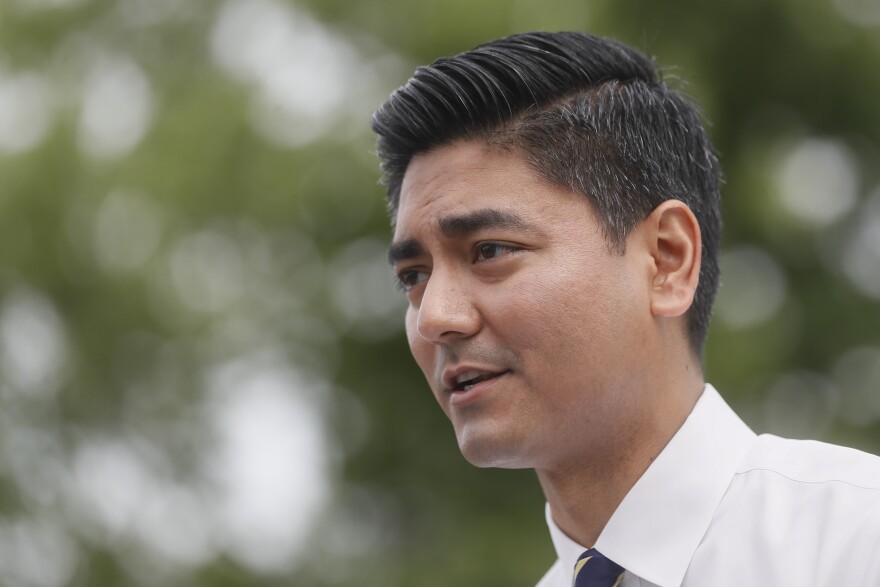Cincinnati's Affordable Housing Trust Fund could be used to subsidize development for the first time ever within the next few months. Officials announced a plan Thursday to bring the fund's total amount to $57 million.
Some of that is contingent on council approval, including about a million dollars annually from existing city funds. Mayor Aftab Pureval says this recurring revenue source would come from the budget surplus at the end of each fiscal year.
"There's a very regimented, statutorily required way that that surplus funds different reserves in our city," he said. "That is driven primarily by credit agencies, trying to get to 16.7% [of the General Fund] in reserves. This amendment will maintain that priority, but we'll include a line item for also including affordable housing as a top priority when that surplus happens."
Pureval also announced a new $5 million deposit into the trust fund from the fiscal year 2021 allocation of federal stimulus from the American Rescue Plan Act. That money is available now because it was first allocated to Fire Department overtime, which the federal government has since determined is not an eligible use for the federal money. (The city has already covered the overtime for fiscal year 2021, which ended last June.)
These two additions to the Affordable Housing Trust Fund require council approval. Pureval says the ordinances will be filed next week and will be in committee the week after.
Plans for managing the fund were put into place nearly a year ago by then-Mayor John Cranley and then-City Manager Paula Boggs Muething. The administration announced a partnership with the Cincinnati Development Fund to manage the logistics of distributing the funds, and a new Housing Advisory Board to establish priorities and parameters.
Pureval says the city is "weeks away" from finalizing the details of the partnership with CDF.
"This will provide a one stop shop for affordable housing developers to apply for and receive the gap financing needed to bring projects to fruition," Pureval said.
As for the Housing Advisory Board, council approved the plan last April and confirmed Cranley's appointees later that year. But the board has yet to meet for the first time. Pureval says he'll release more information about the board in the next couple of weeks and they will meet in mid-March.
The fund's purpose is to provide gap financing for affordable housing preservation and creation.
"Affordable housing developments always have a math/finance problem: there's never enough revenue provided by rent to be able to cover the expenses of building and creating affordable housing," said Kristen Baker, executive director of LISC Cincinnati. "The Trust Fund dollars help the projects be able to get to completion because they serve as filling a gap, a very important gap."
Council established the fund in 2018, but it has never been used for gap financing.
What's known as the Affordable Housing Trust Fund is actually several different "buckets" of money, The goal is to distribute the money to developers as grants or low-interest loans, sometimes forgivable loans. Some of the "buckets" have established parameters for how the money can be spent; for the rest, the CDF and Housing Advisory Board will come up with the eligibility requirements (like levels of affordability based on Area Median Income).
The $57 million total in the trust fund is from a variety of sources, some newly announced this week.
In the fund today: ~$2 million
Council established the fund in 2018; a 7% tax on short-term rentals was originally designated for the fund, but later the money was rerouted.
Private investments:
- $5 million from the Greater Cincinnati Foundation
- $5 million from Western and Southern
- $500k from Heath Path
- $1.5 million from the Haile Foundation
Council Member Reggie Harris says with the city's new investment in the trust fund, CDF will be able to leverage even more private investment funding.
Federal grants: $2.7 million (CDFI Fund)
Cincinnati Development Fund: ~$300,000 from retained earnings
HUD Section 108 Revolving Loan Pool: ~$34 million
This portion of the fund was an effort of former City Manager Paula Boggs Muething, who announced the plan last spring. It required an application that is "weeks away" from being finalized, according to mayoral staff.
The HUD Section 108 funding will be distributed as low-interest loans to developers. As the loans are paid back, the money can be loaned out again for new projects. The maximum loan from Section 108 funding is 20 years.
Section 108 regulations require at least 51% of the "beneficiaries" of the funding be low- or moderate-income persons; in other words, residents making between 50% and 80% of Area Median Income (AMI).
New revenue source: ~$1 million annually
Pureval's proposed change to the city's stabilization funds policy wouldn't reduce the amount the city sets aside for reserves, but instead would reduce the amount of surplus council is able to allocate during the budget closeout process.
The policy requires a portion of carryover money be used for certain "rainy day" funds:
- General Fund Carryover: 1.5% of operating revenue
- General Fund Contingency Account: 2% of operating revenue
- Economic Downturn Reserve: 5% of operating revenue
- Working Capital Reserve: 8.2% of operating revenue
Whatever is left over is allocated to one-time uses suggested by city administration and/or council members. Last fiscal year, council approved a carryover budget with about $10.8 million in stabilization funds and about $3.1 million in one-time uses.
City officials estimate the new line-item for affordable housing will bring in about $1 million annually for the next couple years. Once the city's reserve reaches the goal of 16.7% of the General Fund, the amount going to housing will increase to an estimated $2.5 million annually; that could happen in the next two to four years, depending on revenue.



